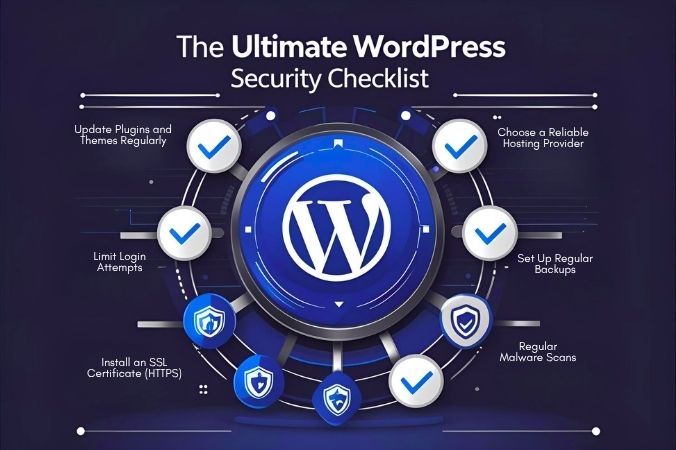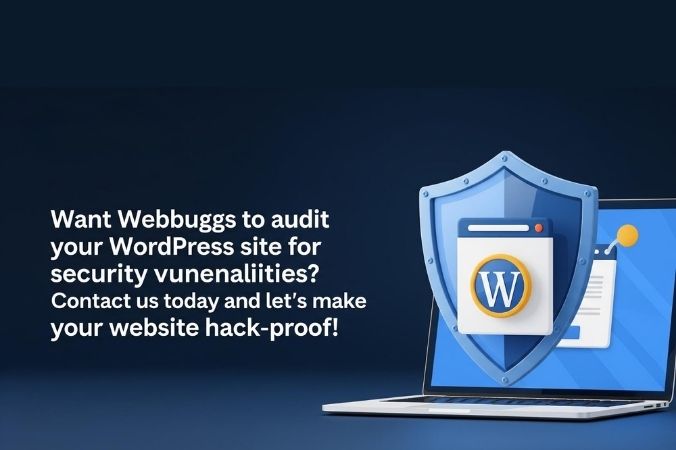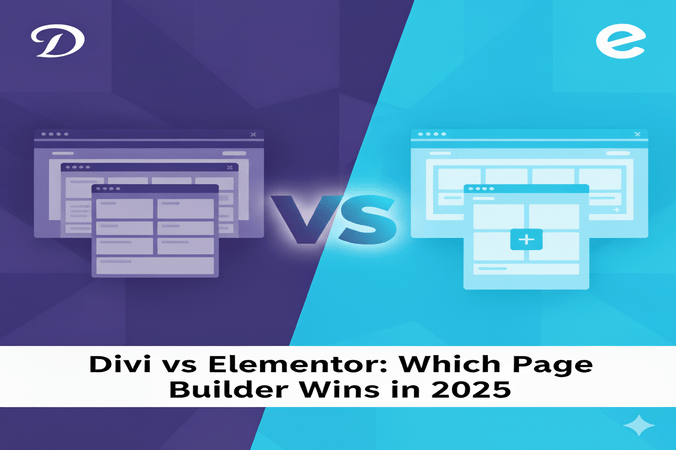The Ultimate WordPress Security Checklist: Keep Your Site Safe in 2025

Running a WordPress website in 2025 is more exciting than ever but it also comes with growing cybersecurity risks. Hackers are getting smarter, malware attacks are more sophisticated, and a single vulnerability could cost you valuable data, customers, and revenue.
At Webbuggs, we know how crucial security is for your online presence. That’s why we’ve created this ultimate WordPress security checklist to help you keep your website safe, fast, and fully protected this year.
1. Keep WordPress Core Updated
One of the easiest yet most effective ways to secure your website is by keeping your WordPress core updated.
- Turn on automatic updates
- Always create a backup before updating
- Remove outdated WordPress installations
Pro Tip: Hackers target outdated sites within hours of a security patch release. Don’t delay updates.
2. Update Plugins and Themes Regularly
Your plugins and themes are gateways to your site — and hackers love exploiting outdated ones.
- Delete plugins/themes you no longer use
- Only install from trusted sources
- Avoid nulled or pirated plugins/themes (they often contain hidden malware)
- Check for frequent updates and positive reviews before installing
At Webbuggs, we recommend auditing your plugins every month to keep your website clean and secure.
3. Use Strong Passwords and Unique Usernames
Weak passwords are an open invitation for brute force attacks.
- Never use “admin” as your username
- Create complex passwords using a password manager
- Change passwords every 3–6 months
- Enable Two-Factor Authentication (2FA) for extra safety
Security plugins like Wordfence make setting up 2FA quick and easy.

4. Limit Login Attempts
Brute force attacks try endless username-password combinations until they succeed. Prevent this with:
- Limit Login Attempts Reloaded plugin
- reCAPTCHA on login pages
- Hiding your login URL with WPS Hide Login
This small step significantly reduces your risk of unauthorized access.
5. Install an SSL Certificate (HTTPS)
In 2025, running a website without HTTPS is a huge red flag. An SSL certificate encrypts data, making it impossible for hackers to steal sensitive information.
- Most hosts provide free SSL via Let’s Encrypt
- Always redirect HTTP to HTTPS
- Look for the padlock icon in your browser
Google even boosts SEO rankings for HTTPS-enabled websites.
6. Secure Your wp-config.php File
The wp-config.php file contains crucial information like database credentials. Protect it by:
- Moving it above the root directory
- Setting strict file permissions (600 recommended)
- Adding unique security keys using WordPress’ secret key generator
7. Choose a Reliable Hosting Provider
Your host is your website’s first line of defense.
Look for:
- Daily automated backups
- Malware scanning and removal
- DDoS protection
- 24/7 support
Webbuggs Tip: Premium hosts like SiteGround, Kinsta, and WP Engine excel at WordPress security.
8. Install a Security Plugin
A good security plugin acts as your website’s bodyguard.
Top choices for 2025:
- Wordfence Security → Malware scanning & firewall
- iThemes Security → Brute force protection & file monitoring
- Sucuri Security → Cloud-based firewall & site monitoring
Just one reliable plugin is enough — don’t overload your site.
9. Set Up Regular Backups
Backups are your safety net. If your site gets hacked, you can restore it within minutes.
- Use UpdraftPlus or BlogVault
- Store backups in Google Drive or Dropbox
- Automate daily or weekly backups
- Test your backups regularly
At Webbuggs, we always recommend offsite backups for maximum safety.
10. Manage User Roles and Permissions
Not everyone needs admin access. Give permissions wisely.
- Assign roles (Admin, Editor, Author, etc.) carefully
- Remove inactive accounts
- Regularly review who has access
For e-commerce sites, restrict access to customer data only to trusted staff.
11. Enable a Web Application Firewall (WAF)
A WAF filters out malicious traffic before it reaches your site.
- Use cloud-based WAFs like Cloudflare or Sucuri
- Block brute force and DDoS attacks
- Improve your site speed with CDN integration
12. Regular Malware Scans
Cyber threats evolve daily. Stay ahead with regular scans.
- Run weekly malware scans with plugins like MalCare
- Monitor suspicious login attempts
- Set up instant alerts for unusual activity
13. Disable XML-RPC (If Not Needed)
XML-RPC is rarely used today but often exploited for attacks.
- Disable it using the Disable XML-RPC plugin
- Block it via .htaccess if you don’t need it
If you use Jetpack or remote publishing, you may need XML-RPC — otherwise, keep it off.
14. Protect Your wp-admin Directory
Your admin panel is the heart of your site. Add an extra layer of security:
- Password-protect the wp-admin directory
- Restrict access by IP
- Monitor failed login attempts
15. Stay Updated With WordPress Security News
Cybersecurity is always evolving. Stay informed through:
- Wordfence blog
- Sucuri blog
- WPBeginner security guides
- Webbuggs’ own security updates
Knowledge is your strongest defense.
Final Thoughts
Securing your WordPress site in 2025 doesn’t have to be overwhelming. By following this ultimate WordPress security checklist from Webbuggs, you can protect your site from hackers, boost customer trust, and safeguard your online business.
Remember, WordPress security isn’t a one-time task — it’s an ongoing process.
Stay proactive, update regularly, and let Webbuggs guide you toward a safer digital future.
Want Webbuggs to audit your WordPress site for security vulnerabilities?
Contact us today and let’s make your website hack-proof!
.svg)




